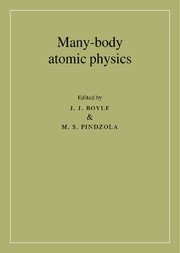Book contents
- Front Matter
- Contents
- Foreword
- Contributors
- Preface
- Acknowledgements
- Part 1 ATOMIC STRUCTURE
- Part 2 PHOTOIONIZATION OF ATOMS
- Part 3 ATOMIC SCATTERING: A. General Considerations
- 8 The many-body approach to electron-atom collisions
- 9 Theoretical aspects of electron impact ionization, (e, 2e), at high and intermediate energies
- Part 3 ATOMIC SCATTERING: B. Low-order applications
- Part 3 ATOMIC SCATTERING: C. All-order applications
- Appendix: Units and notation
- References
- Index
8 - The many-body approach to electron-atom collisions
Published online by Cambridge University Press: 22 September 2009
- Front Matter
- Contents
- Foreword
- Contributors
- Preface
- Acknowledgements
- Part 1 ATOMIC STRUCTURE
- Part 2 PHOTOIONIZATION OF ATOMS
- Part 3 ATOMIC SCATTERING: A. General Considerations
- 8 The many-body approach to electron-atom collisions
- 9 Theoretical aspects of electron impact ionization, (e, 2e), at high and intermediate energies
- Part 3 ATOMIC SCATTERING: B. Low-order applications
- Part 3 ATOMIC SCATTERING: C. All-order applications
- Appendix: Units and notation
- References
- Index
Summary
Introduction
Many-body theory has been very successful in the ab initio calculation of electron–atom scattering cross sections. Its application has made it possible to take into account the target atom polarization in the collision process without the introduction of a semi-empirical potential. The many-body approach and the diagrammatic technique associated with it have also permitted the illumination of hidden difficulties in the description of the electron-atom scattering process.
The first calculations of electron–hydrogen elastic scattering cross sections using the diagrammatic technique of many-body theory were performed by H. P. Kelly about thirty years ago. In that calculation, as well as in subsequent investigations involving helium, argon and xenon, the polarization of the target atom by slow and medium energy electrons was taken into account. The effects of the exchange between the projectile electrons and target electrons were also accounted for. Although, at first glance, the interaction between the incoming electrons and the atomic particles is of second order, the polarization of the target in these works included a number of higher order corrections. This inclusion has proven to be very important.
The subsequent application of many-body theory to the scattering of electrons from highly polarizable atoms led to the development of methods which permitted the incorporation of the corresponding corrections non-perturbatively. A connection between elastic scattering and negative ion formation has also allowed one to use many-body techniques for the calculation of electron affinities.
- Type
- Chapter
- Information
- Many-Body Atomic Physics , pp. 185 - 212Publisher: Cambridge University PressPrint publication year: 1998
- 1
- Cited by

